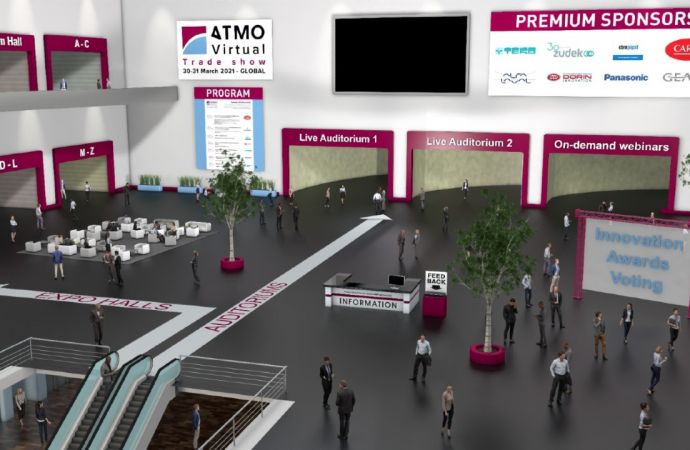In a paper, titled « Comparing evaporative and air cooled condensing for ammonia systems », presented at the last IIAR Conference, the author Doug Scott from VaCom Technologies (La Verne, CA), reports on the results of a study measuring efficiency and utility costs of refrigerated warehouses using ammonia refrigeration systems in six U.S. cities, comparing evaporative and air cooled condensing.

Whilst evaporative condensing has been the standard for ammonia systems, some suggest that the use of air-cooled condensers for ammonia systems is an attractive, although not a commonly used technology. Air-coolded condensing could help address increased water costs as well as reduced water availability, which in many areas are making water conservation an important component of sustainability efforts for many companies. The efficient use of air-cooled condensing could thus allow the benefits of ammonia to be realised more widely.
Why evaporative cooling was preferred
Evaporative condensing has been the standard for ammonia refrigeration systems due to a number of factors:
Study methodology
This study is based on hourly simulation of air-cooled and evaporative cooled condensing in a medium sized refrigerated warehouse with freezer, cooler and dock spaces. The ammonia refrigeration system uses two suction levels, each with two equal-size screw compressors.
Six cities were used for the study to obtain a range of weather conditions (Dallas TX, Chicago IL, Denver CO, Miami FL, Salinas CA and Portland OR) and the comparison involved plant annual energy consumption, local utility costs for electricity and water usage, cooling design loads and condenser specific efficiency.
The evap cooled condenser selections for each location were made using the
compressor total heat of rejection (THR), based on compressor capacity, and using the approach (i.e. temperature difference) between saturated condensing temperature (SCT) and entering wet bulb temperature,
The air cooled condenser selections were based on a 15°F (8.3°K) approach between SCT and entering dry bulb temperature (DBT). The air cooled design approach is the same for all ambient conditions.
Particular attention was paid to head pressure control to optimise the energy consumption of the compressors and condensers fans.
Air-cooled versus evaporative-cooled: uses more energy and more costly, but favourable if water consumption is considered
In all locations, air-cooled condensing uses more total energy (kWh) than evaporative cooled condensing ranging from almost no increase to an 8% increase in Denver, Colorado.
Based on high level estimates by the author, the added capital cost for air cooled condensing on the subject facility is estimated between $200,000 and $300,000, which would equate to a payback of 10 to 30 years.
Energy cost is also greater in all areas evaluated: Electric cost increase ranged from approximately 3% to 12%. But when water costs are considered, the net operating cost is lower in all six U.S. locations considered in this paper (ranging from 4% to 21%).
The author concludes more hands-on tests are needed to evaluate average performance of both evaporative-cooled and air-cooled condensers. Specific analyses are also required to identify accurate operating costs of both options depending on local water costs and utility rates.
Why evaporative cooling was preferred
Evaporative condensing has been the standard for ammonia refrigeration systems due to a number of factors:
- Evaporative condensers reject heat from refrigeration and air conditioning systems while using minimum quantities of energy and water.
- The evaporative condenser essentially combines a cooling tower and a refrigerant condenser in one piece of equipment.
- Higher design pressures required for air-cooled systems affect all components of the system.
- During compression ammonia produces high discharge pressures, exacerbated by air cooled systems, which is difficult to address when using reciprocating compressors.
Study methodology
This study is based on hourly simulation of air-cooled and evaporative cooled condensing in a medium sized refrigerated warehouse with freezer, cooler and dock spaces. The ammonia refrigeration system uses two suction levels, each with two equal-size screw compressors.
Six cities were used for the study to obtain a range of weather conditions (Dallas TX, Chicago IL, Denver CO, Miami FL, Salinas CA and Portland OR) and the comparison involved plant annual energy consumption, local utility costs for electricity and water usage, cooling design loads and condenser specific efficiency.
The evap cooled condenser selections for each location were made using the
compressor total heat of rejection (THR), based on compressor capacity, and using the approach (i.e. temperature difference) between saturated condensing temperature (SCT) and entering wet bulb temperature,
The air cooled condenser selections were based on a 15°F (8.3°K) approach between SCT and entering dry bulb temperature (DBT). The air cooled design approach is the same for all ambient conditions.
Particular attention was paid to head pressure control to optimise the energy consumption of the compressors and condensers fans.
Air-cooled versus evaporative-cooled: uses more energy and more costly, but favourable if water consumption is considered
In all locations, air-cooled condensing uses more total energy (kWh) than evaporative cooled condensing ranging from almost no increase to an 8% increase in Denver, Colorado.
Based on high level estimates by the author, the added capital cost for air cooled condensing on the subject facility is estimated between $200,000 and $300,000, which would equate to a payback of 10 to 30 years.
Energy cost is also greater in all areas evaluated: Electric cost increase ranged from approximately 3% to 12%. But when water costs are considered, the net operating cost is lower in all six U.S. locations considered in this paper (ranging from 4% to 21%).
The author concludes more hands-on tests are needed to evaluate average performance of both evaporative-cooled and air-cooled condensers. Specific analyses are also required to identify accurate operating costs of both options depending on local water costs and utility rates.
MORE INFORMATION
Related stories



